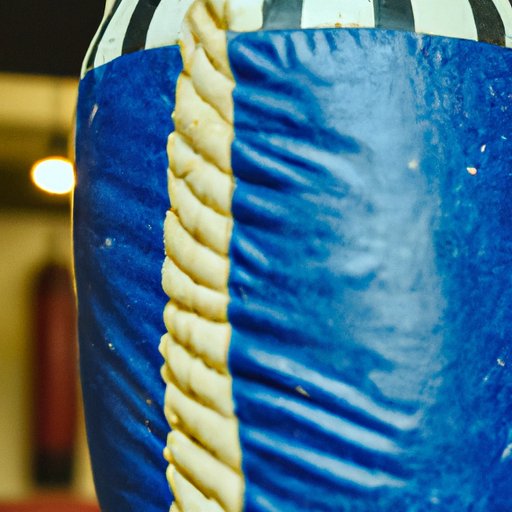Introduction
A punching bag is an excellent tool for physical fitness, boxing training, martial arts, and self-defense. Not only does it provide an effective full-body workout, but it also helps build strength, speed, and agility. Whether you’re a beginner or a pro, mastering the art of punching a punching bag is essential for any successful workout routine.
Step-by-Step Guide to Punches for a Punching Bag
Getting started with punching a punching bag is easy. The first step is to establish a good stance. Stand with your feet shoulder-width apart, keep your knees slightly bent, and maintain a relaxed posture. You should be able to move quickly and efficiently in any direction.
Once you’ve established your stance, you can begin to practice different types of punches. Common punches include jabs, crosses, hooks, uppercuts, overhands, and spinning backfists. Each type of punch has its own unique uses and benefits. For example, jabs are quick and efficient, while hooks are great for power and accuracy.
You can also combine different types of punches for a more intense workout. Start by mixing basic punches like jabs and crosses, then gradually add more complex combinations. As you become more comfortable, you can increase the intensity of your punches and incorporate more advanced techniques.
10 Tips for Perfect Punches on a Punching Bag
The key to mastering punches on a punching bag is proper form and technique. Here are 10 tips to help you perfect your punches:
- Keep your form tight and your punches accurate. Make sure you’re not overextending your arms and that you stay focused on your target.
- Breathe properly. Take deep breaths and exhale as you punch. This will help you stay focused and energized throughout your workout.
- Increase intensity gradually. Don’t rush into a high-intensity workout. Start slow and work your way up.
- Stay focused. Don’t let your mind wander. Focus on your punches and make sure you’re hitting the right spots.
- Rest between sets. Take breaks between sets to give your body time to recover.
- Use proper hand placement. Make sure your hands are in the correct position when you punch.
- Use proper footwork. Keep your feet firmly planted on the ground as you punch and move around the punching bag.
- Wear proper equipment. Invest in quality gloves, wraps, and other protective gear to ensure you’re safe when punching the bag.
- Vary your punches. Don’t just stick to one type of punch. Mix up your routine to work different muscle groups.
- Visualize success. Visualizing yourself successfully executing each punch will help you stay motivated and push yourself harder.

Combining Punches for the Perfect Punching Bag Workout
Once you’ve mastered the basics, you can start combining punches for a more intense workout. Start by throwing basic punches like jabs and crosses. As you become more comfortable, increase the intensity and add more complex combinations. Focus on speed and accuracy, and don’t forget to rest between sets.

Punching Bag Training: How to Properly Execute Different Punches
Now that you know the basics of punching a punching bag, let’s take a look at some of the different types of punches you can use. Here’s a quick overview of the most common punches:
- Jab: A quick, straight punch thrown with the lead hand.
- Cross: A powerful punch thrown with the rear hand.
- Hook: A curved punch thrown with either hand.
- Uppercut: An upward punch thrown with either hand.
- Overhand: An overhead punch thrown with the rear hand.
- Spinning Backfist: A powerful punch thrown with the rear hand while spinning.

The Basics of Punching Bag Training: Types of Punches and Techniques
Mastering different types of punches is essential for successful punching bag training. It’s also important to understand proper technique and form. As you practice, focus on developing proper technique, building strength and endurance, and increasing the speed and accuracy of your punches.
Conclusion
Punching a punching bag is a great way to get an effective full-body workout. With proper form and technique, you can master different types of punches and create a powerful routine. From jabs and crosses to uppercuts and spinning backfists, there are plenty of punches to choose from. With dedication and practice, you’ll be able to reap the many benefits of punching bag training.


